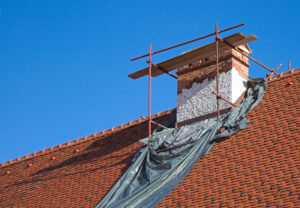
Let’s go over what to know about new chimney building.
Chimneys are one of the most popular features homeowners look for when they purchase a new home. There’s nothing like sitting by the fire on a cold fall or winter night.
Homeowners decide to purchase and install new fireplaces for various reasons: either upgrading from their existing masonry structure, changing out an old factory-built fireplace, or changing the look and feel of their home. However, there are some things to be cautious of when building a new chimney. Below, we’ve highlighted some tips and information for building a new chimney and fireplace.
Placing Your New Chimney
Choosing the perfect spot for your chimney should include more than home design. For a chimney that functions optimally in cold climates, it’s best not to have a chimney along an outside wall. Extreme winter weather can create a cold column of air in your chimney, making it tough to start fires. If the chimney is enclosed within the structure of your home, it will be more ready to provide a warming fire, no matter how cold it is outside.
How High Should Your Chimney Be?
Whatever type of chimney you have needs to extend 2 feet higher than anything within 10 feet horizontally of its peak. It must also be at least 3 feet higher than the point at which the chimney connects with the roof. Chimney height is important to ensure a proper draft that pulls combustion fumes outside through the chimney. It is also a safety issue that helps eliminate fire hazards.
Ensure Your Chimney is Properly Lined
A chimney liner is a requirement for every masonry chimney. Fire safety experts deemed it necessary when they noticed the dangers of using a chimney without a liner.
Your chimney liner will keep the toxic combustion gases that form from the fire in the chimney until they escape outside your home. The gases, including carbon monoxide, can appear in your home without a chimney flue liner. Chances are you won’t even know carbon monoxide is in your home until it’s too late. It’s best to install a chimney liner to prevent any unwanted gases.
Your chimney liner can also prevent creosote from building up. If a burning ember is floating up the chimney, the creosote can ignite and cause more damage.
Building Codes
Your chimney will need to comply with local building ordinances. Your local Zoning department may require its architectural design approval before issuing a building permit for chimney construction. The chimney will likely need to pass additional inspections while it is being built and upon completion before it is approved for use.
Schedule Your Chimney Cleaning from Champion Chimneys, Inc.
When you need a trusted company for your chimney inspection and chimney cleaning, you can trust our team. Champion Chimneys, Inc. is a fully licensed, bonded, and insured chimney service company that has served customers in Baltimore County, Howard County, and Anne Arundel County, Maryland, since 2001. Our team is trained and certified by Certified Chimney Professionals, Inc. (CCP, Inc.). We specialize in all aspects of your chimney system. Whether you need chimney and flue cleaning service or a full chimney rebuild or inspection, contact us at 443-Chimney today and let us fix all your chimney problems. Also, follow us on Facebook, Twitter, LinkedIn, and Pinterest.
